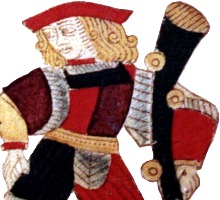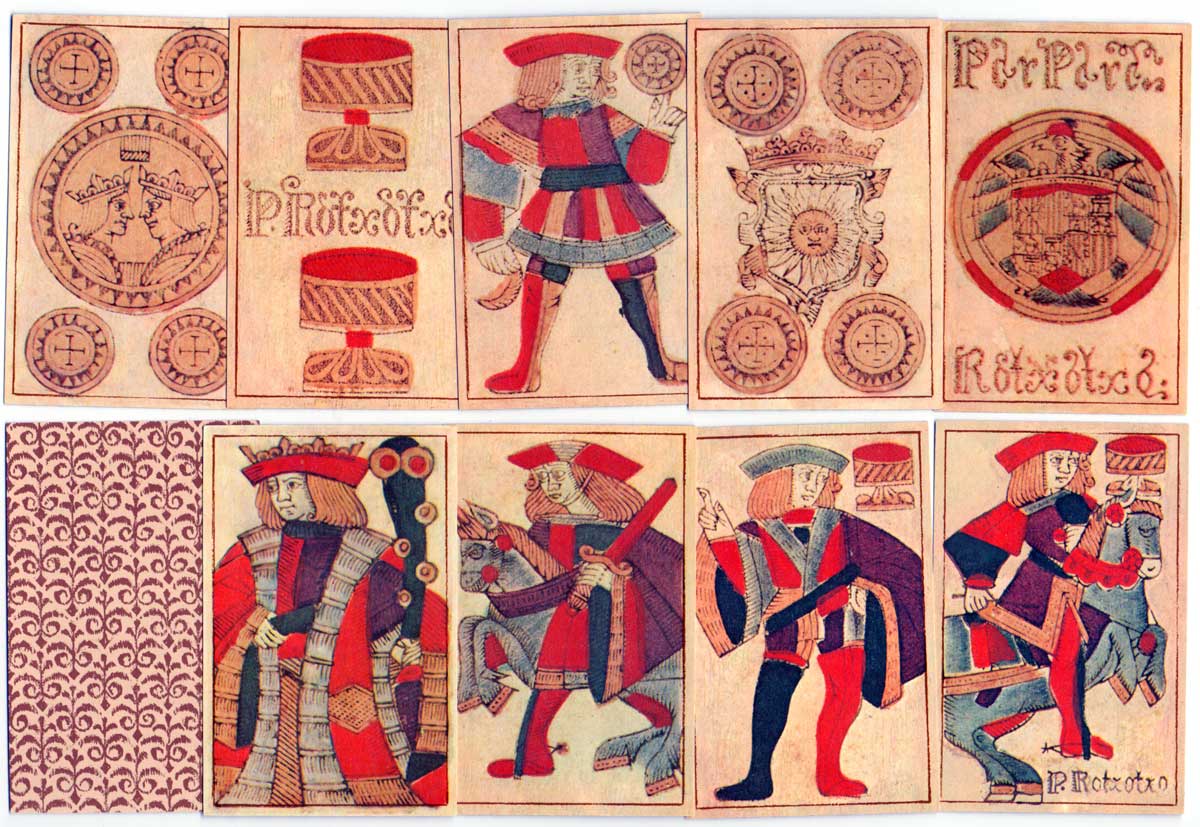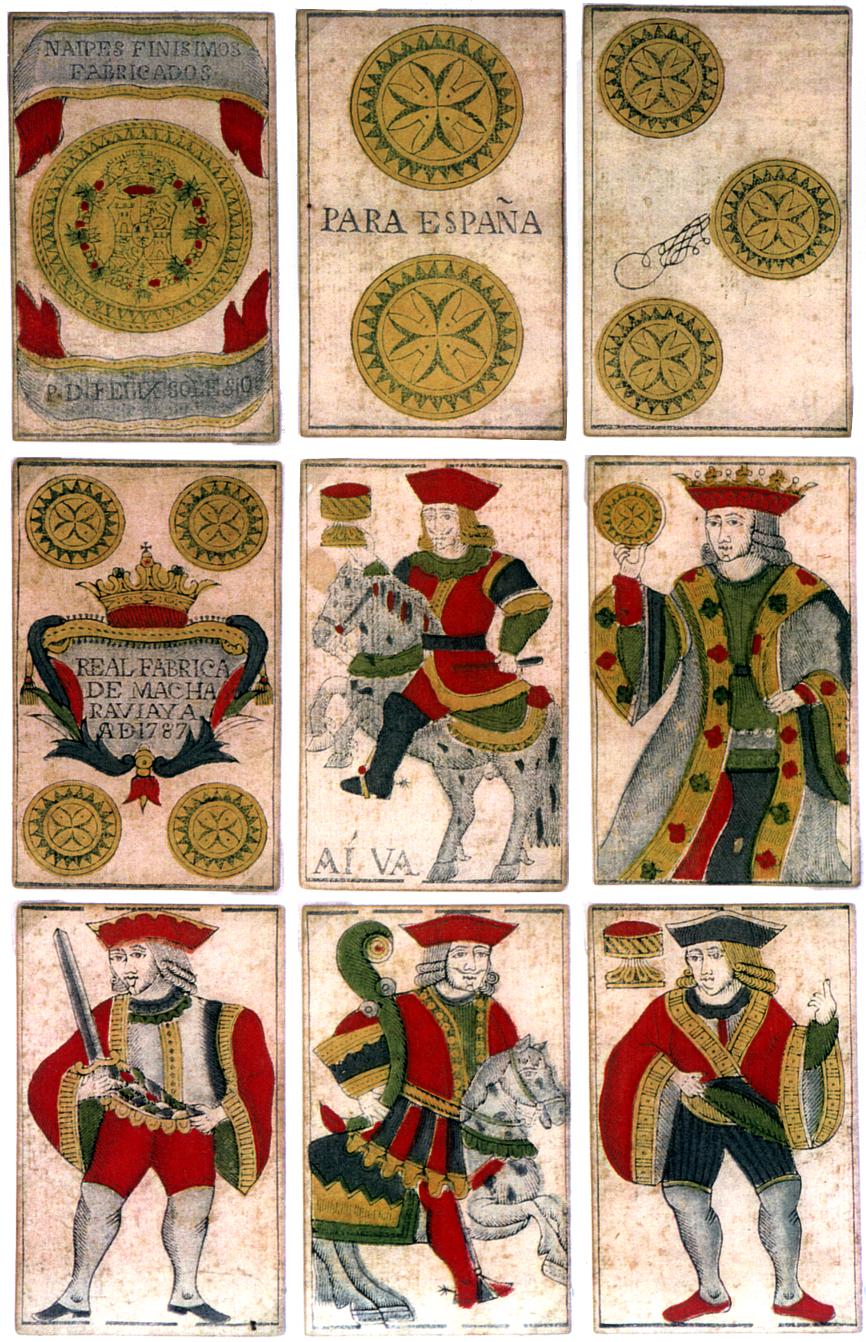Spanish National Pattern
Probably originating in Spain in the seventeenth century or even earlier, this pattern became strongly established by the Catalan cardmakers Rotxotxo of Barcelona.

Pere Rotxotxo, Barcelona, c.1650
Probably originating in Spain in the seventeenth century or even earlier, this pattern became strongly established by the Catalan cardmakers Rotxotxo of Barcelona. It was also manufactured in France and Italy. Although no longer used in Spain, during the 17th and 18th centuries it was extensively exported to Latin American colonies, and it provides the basis for many of the designs which are used today in Spain as well as South America. The Real Fábrica de Naipes de Macharaviaya (1776-1815) was manufacturing cards for export to South America based on these designs (see below). Several derivatives of this deisgn have survived in various parts of the world, such as French ‘Aluette’ cards, French ‘Cartes Catalanes’, ‘Parisian’ Spanish pattern (used in Uruguay) and cards used in North Africa.

Above: six Gothic playing cards by P. Rotxotxo which evidently have been used for a secondary purpose - possibly sewn in as stiffening inside a garment.

Above: Baraja Española Gótica siglo XVII facsimile of deck manufactured by Pere Rotxotxo, reproduced by Naipes Heráclio Fournier, S.A., 1983. 40 cards in presentation case.
See also: Navarra 17th Century • Seville 17th Century • Rotxotxo Workshop Inventories, Barcelona • Agostino Bergallo • Benoist Laius • Pedro Bosio and ‘Money Bag’ pattern • Joan Barbot • Gandarillas • Naipes Artiguistas • Macharaviaya
Félix Solesio - Real Fábrica de Macharaviaya, 1787

Official signatures on certain cards, in this example the Three of Coins, were proof that taxes had been paid to the treasury.

By Simon Wintle
Member since February 01, 1996
I am the founder of The World of Playing Cards (est. 1996), a website dedicated to the history, artistry and cultural significance of playing cards and tarot. Over the years I have researched various areas of the subject, acquired and traded collections and contributed as a committee member of the IPCS and graphics editor of The Playing-Card journal. Having lived in Chile, England, Wales, and now Spain, these experiences have shaped my work and passion for playing cards. Amongst my achievements is producing a limited-edition replica of a 17th-century English pack using woodblocks and stencils—a labour of love. Today, the World of Playing Cards is a global collaborative project, with my son Adam serving as the technical driving force behind its development. His innovative efforts have helped shape the site into the thriving hub it is today. You are warmly invited to become a contributor and share your enthusiasm.
Related Articles

Pierre Varangot
Tracing the origins, legality and legacy of Pierre Varangot’s San Sebastián deck.

Archaic Spanish-suited pattern from Bayonne
Archaic Franco-Spanish pattern from Bayonne by a manufacturer with the initals M.V.

French Revolutionary cards by Pinaut
Seven cards from a French Revolutionary pack by Pinaut featuring characters from classical antiquity...

Tarot de las Coscojas
Historical playing card design, tarot symbolism and an almost psychedelic medieval surrealism.

Tarot de Valverde de la Vera
A series of 24 surrealist engravings by Mexican artist Claudio Favier in which archetypal Tarot alle...

Baraja de Juan Martín Zamorano
Deck inspired by El Pendón de los Zamorano, a military pennant dating from 1501, published by Priego...

Heráldica Castanyer No. 16
Strange variant of international pattern cards for poker or bridge.

Fantasy Spanish-suited deck
Fantasy Spanish-suited deck by Bertschinger y Codina, Barcelona.

Trappola cards from Poland
Trappola cards published in Warsaw by J G Du Port during the 18th century.

Bertschinger y Codina - Cartes Françaises
French ‘Paris’ pattern made by Bertschinger y Codina, Barcelona, c.1850.

Braulio Fournier
Baraja Nº 1 produced by Braulio Fournier, Burgos, c.1868.

Pirritx eta Porrotx
Happy Families card game from the Spanish Basque Country.

Naipe Vizcaino
‘Naipe Vizcaino’ designed by Javier Urkiri and published by Industrias Gráficas Castuera and the Caj...

Baraja Turística del País Vasco
Basque poker deck of 55 cards published by Fournier with scenic views of the Basque Country.

Baraja Vasca
Spanish Basque Country deck with original drawings by María Isabel Ibañez de Sendadiano.

Baraja Cultura Española
ASESCOIN pack for 2022 designed by M.A. Corella featuring famous Spaniards and notable buildings.
Most Popular
Our top articles from the past 28 days

